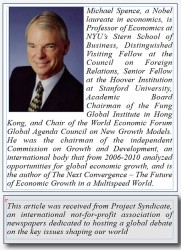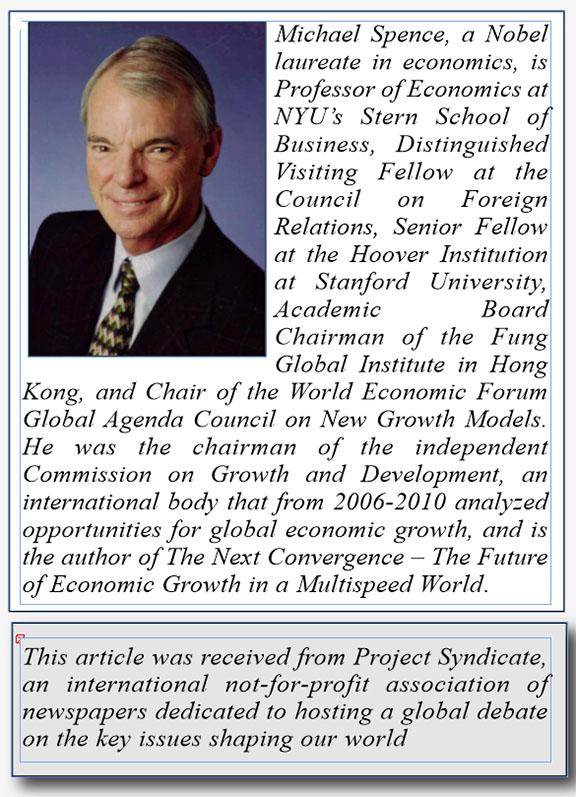By Michael Spence
MILAN – When World War II ended 70 years ago, much of the world – including industrialized Europe, Japan, and other countries that had been occupied – was left geopolitically riven and burdened by heavy sovereign debt, with many major economies in ruins. One might have expected a long period of limited international cooperation, slow growth, high unemployment, and extreme privation, owing to countries’ limited capacity to finance their huge investment needs. But that is not what happened.
 Instead, world leaders adopted a long-term perspective. They recognized that their countries’ debt-reduction prospects depended on nominal economic growth, and that their economic-growth prospects – not to mention continued peace – depended on a worldwide recovery. So they used – and even stretched – their balance sheets for investment, while opening themselves up to international trade, thereby helping to restore demand. The United States – which faced considerable public debt, but had lost little in the way of physical assets – naturally assumed a leadership role in this process.
Instead, world leaders adopted a long-term perspective. They recognized that their countries’ debt-reduction prospects depended on nominal economic growth, and that their economic-growth prospects – not to mention continued peace – depended on a worldwide recovery. So they used – and even stretched – their balance sheets for investment, while opening themselves up to international trade, thereby helping to restore demand. The United States – which faced considerable public debt, but had lost little in the way of physical assets – naturally assumed a leadership role in this process.
Two features of the post-war economic recovery are striking. First, countries did not view their sovereign debt as a binding constraint, and instead pursued investment and potential growth. Second, they cooperated with one another on multiple fronts, and the countries with the strongest balance sheets bolstered investment elsewhere, crowding in private investment. The onset of the Cold War may have encouraged this approach. In any case, it was not every country for itself.
Today’s global economy bears striking similarities to the immediate post-war period: high unemployment, high and rising debt levels, and a global shortage of aggregate demand are constraining growth and generating deflationary pressures. And now, as then, the level and quality of investment have been consistently inadequate, with public spending on tangible and intangible capital – a critical factor in long-term growth – well below optimal levels for some time.
Of course, there are also new challenges. The dynamics of income distribution have shifted adversely in recent decades, impeding consensus on economic policy. And aging populations – a result of rising longevity and declining fertility – are putting pressure on public finances.
Nonetheless, the ingredients of an effective strategy to spur economic growth and employment are similar: available balance sheets (sovereign and private) should be used to generate additional demand and boost public investment, even if it results in greater leverage. Recent IMF research suggests that, given excess capacity, governments would probably benefit from substantial short-run multipliers. More important, the focus on investment would improve prospects for long-term sustainable growth, which would enable governments and households to pursue responsible deleveraging.
Likewise, international cooperation is just as critical to success today as it was 70 years ago. Because the balance sheets (public, quasi-public, and private) with the capacity to invest are not uniformly distributed around the world, a determined global effort – which includes an important role for multilateral financial institutions – is needed to clear clogged intermediation channels.
There is plenty of incentive for countries to collaborate, rather than using trade, finance, monetary policy, public-sector purchasing, tax policy, or other levers to undermine one another. After all, given the connectedness that characterizes today’s globalized financial and economic systems, a full recovery anywhere is virtually impossible without a broad-based recovery nearly everywhere.
Yet, for the most part, limited cooperation has been the world’s chosen course in recent years, with countries believing not only that they must fend for themselves, but also that their debt levels impose a hard constraint on growth-generating investment. The resulting underinvestment and depreciation of the global economy’s asset base are suppressing productivity growth and thus undermining sustainable recoveries.
In the absence of a vigorous international re-investment program, monetary policy is being used to prop up growth. But monetary policy typically focuses on domestic recovery. And, though unconventional measures have reduced financial instability, their effectiveness in countering widespread deflationary pressures or restoring growth remains dubious.
Meanwhile, savers are being repressed, asset prices distorted, and incentives to maintain or even increase leverage enhanced. Competitive devaluations, even if they are not policymakers’ stated objectives, are becoming increasingly tempting – though they will not solve the aggregate-demand problem.
This is not to say that sudden “normalization” of monetary policy is a good idea. But, if large-scale investment and reform programs were initiated as complements to unconventional monetary-policy measures, the economy could move onto a more resilient growth path.
Despite its obvious benefits, such a coordinated international approach remains elusive. Though trade and investment agreements are being negotiated, they are increasingly regional in scope. Meanwhile, the multilateral trade system is fragmenting, along with the consensus that created it.
Given the level of interconnectedness and interdependence that characterizes today’s global economy, the reluctance to cooperate is difficult to comprehend. One problem seems to be conditionality, with countries unwilling to commit to complementary fiscal and structural reforms. This is especially evident in Europe, where it is argued, with some justification, that, without such reforms, growth will remain anemic, sustaining or even exacerbating fiscal constraints.
But if conditionality is so important, why didn’t it prevent cooperation 70 years ago? Perhaps the idea that severely damaged economies, with limited prospects for independent recoveries, would pass up the opportunity that international cooperation presented was implausible. Maybe it still is. If so, creating a similar opportunity today could change the incentives, trigger the required complementary reforms, and put the global economy on course to a stronger long-term recovery. © Project Syndicate









